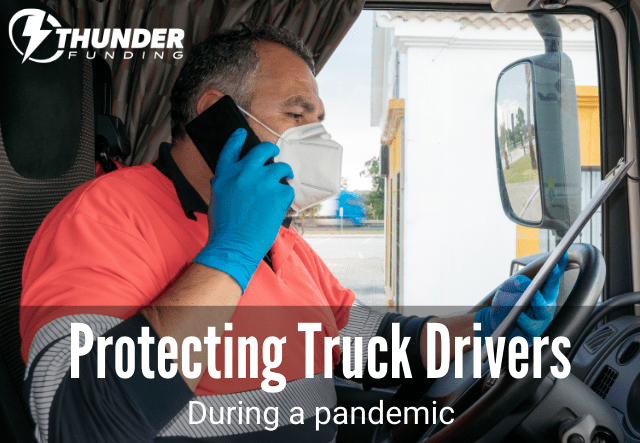Protecting Truck Drivers During A Pandemic


Truck drivers continue to be on the front lines of the coronavirus pandemic as they tirelessly supply our first responders and essential service industries. So, you can understand why it’s important to not only know how COVID-19 is spread, but what truckers can do to prevent themselves from getting it, and the protocol they need to follow if they do contract it.
Understanding How COVID-19 Is Spread
Research has shown that the virus is mainly spread from person-to-person:
- Between people who are in close contact with one another (within about 6 feet)
- Through respiratory droplets produced when an infected person coughs, sneezes, or talks
Recent studies indicate that the virus can also be spread by people who are asymptomatic — ie. those who have the virus but do not show any outward symptoms at all. It may be possible that a person can get COVID-19 by touching a surface or object that has the virus on it and then subsequently touching their own mouth, nose, or possibly their eyes. Older adults and people of any age who have serious underlying medical conditions may be at higher risk for more serious complications from COVID-19.
Symptoms Of COVID-19
People with COVID-19 have reported a wide range of symptoms ranging from mild to severe. According to the CDC, symptoms may appear 2-14 days after exposure to the virus. People with these symptoms may have COVID-19:
- Fever or chills
- Cough
- Shortness of breath or difficulty breathing
- Fatigue
- Muscle or body aches
- Headache
- New loss of taste or smell
- Sore throat
- Congestion or runny nose
- Nausea or vomiting
- Diarrhea
5 Tips For How Truckers Can Protect Themselves (and, Others) From Coronavirus
1. Personal Protective Equipment
The CDC recommends wearing cloth face coverings in public settings when other social distancing measures are difficult to maintain — especially in areas of significant community-based transmission. Avoid large groups and close contact with others. We also recommend wearing gloves and safety glasses when picking up and dropping off loads, stopping at rest stops, and even when at the gas pumps.
2. Cash or Credit
Whenever possible, use your card to pay because cash is just not clean. Even better, try to use contactless payment options such as ApplePay, SamsungPay, or GooglePay if the situation allows for it. Doing so can help limit your contact with hard surfaces where the coronavirus can live for up to 3 hours if not properly disinfected.
3. Eating Out…Or, Dining In
There has never been a better time to practice your sandwich making skills. Break out your cooler, fill it with ice, and stack it to the brim with your own wraps, salads, sandwiches, fruits, vegetables, dips, nuts, and other easy-to-pack snacks. Order your food to-go if you didn’t pack anything to eat for the ride and, if you must go into a store, consider buying your food and drinks in bulk. The point here is to limit your contact with others by limiting the number of times you have to go into places like grocery stores, restaurants, and the like.
4. When Nature Calls
When you gotta go, you gotta go. But, something to be mindful of is that public restrooms may or may not have toilet paper properly stocked. So, be sure to bring some of your own and always wash your hands for at least 20 seconds with soap. It’s also unclear as to how often these restrooms get sanitized by staff so use your elbows and sleeves to open and lock your stall doors. If you’re a long haul driver that requires a shower, consider bringing your own shampoo, conditioner, soap, and whatever other necessities you need. Now, is not the time to be sharing communal items.
5. Constantly Clean and Disinfect
As a truck driver, you’re in your cab most of the time. But, for the times when you have to get out, we can’t stress enough how important it is to clean and disinfect frequently touched surfaces on a routine basis. This includes the following:
- In the truck cab: driver door handle, steering wheel, seat belt and buckle, arm and headrest, seat cover, turn signal, wiper controls, dashboard, air ducts, radio, and temperature controls.
- In the sleeper berth: light switches, mattress tray, temperature controls, and other flat surfaces.
- If a third party has to have access to the interior of your truck such as mechanics, other drivers, or inspectors, request that the third party clean and disinfect the truck before turning it back over to you. Then, clean it again yourself.
- Wash your hands before and after you eat, interact with other people, etc.
- Always have hand sanitizer close by as well as EPA-approved disinfecting wipes or cleaning products.
What To Do If You Show Symptoms of COVID-19
First of all, stay calm. If you think you’re exhibiting COVID-19 symptoms, review the CDC’s recommendations for what to do if you think you are sick:
- Notify your supervisor and stay home if you’re experiencing symptoms.
- Make a plan with your employer and your family as to what to do if you become sick while you’re on the road. Include where to stop, where and how to seek medical advice and treatment, and plans for freight delivery.
- You should not return to work until the criteria to discontinue home isolation are met, in consultation with healthcare providers and state and local health departments.
Use your common sense and stay vigilant when it comes to your own health and safety. Make plans with your employers and family in case anything were to happen. And, ensure you have everything you need in your truck to protect yourself before heading out on the open road.
For more information about the trucking industry and the coronavirus be sure to check out this blog post: The Life of a Truck Driver in the Midst of COVID-19
